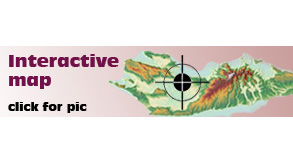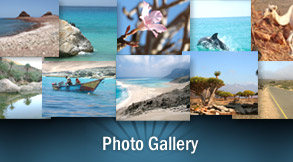
Biodiversity of Socotra
Due to its size, geographic position and evolutionary history, the Socotra Archipelago is a prime regional center of unique biodiversity. From a botanical point of view, Socotra is historically known for the rare and spectacular plants that characterize the dramatic mountain and coastal landscapes. You can find magic dragon blood trees, desert roses, cucumber trees, frankincense trees, etc. According to botanists, the island of Socotra ranks among the top of endangered islands in the world.
The Archipelago is often referred to as "the Galapagos of the Indian Ocean" due to the richness of its fauna. Hundreds of endemic animal species include 28 reptiles, 10 birds and over 300 invertebrates. Birdlife International identifies over 22 "Important Bird Areas" on the island. They include spectacular seabird breeding areas as well as the habitats of species and subspecies of endemics, which add to the islands’ high uniqueness.
|
Species
|
Total Amount
|
Endemic
|
|
Terrestrial Plants
|
835
|
308
|
|
Birds
|
205
|
10
|
|
Terrestrial Reptiles
|
31
|
28
|
|
Terrestrial Invertebrates
|
800*
(Dragonflies 18)
|
N/A
(Dragonflies 1,
60 % for spiders, 100 % for scorpions) |
*provisional number
International Status of Socotra
UNESCO Man and Biosphere Reserve since 2003.
UNESCO World Natural Heritage Site since 2008.
Socotra xeric shrublands listed as one of the WWF Global 200 ecoregions - most biologically diverse and representative habitats.
The Birdlife International pronounced Socotra as one of the world’s 218 Endemic Bird Areas - critical regions for the conservation of the world's birds and other biodiversity.
The Birdlife International recognizes 22 Important Bird Areas in the Archipelago being the key sites for conservation.
Ditwah Lagoon listed as one of the Wetlands of International Importance after Yemen signed the Ramsar Convention on Wetlands in 2008.
As a part of the Horn of Africa Biodiversity Hotspot, The Conservation International listed Socotra among 34 richest and most threatened reservoirs of plant and animal life on Earth.
The International Union for Conservation of Nature names 52 endemic Socotran plants in the Red List of Threatened Species.
UNESCO Man and Biosphere Reserve since 2003.
UNESCO World Natural Heritage Site since 2008.
Socotra xeric shrublands listed as one of the WWF Global 200 ecoregions - most biologically diverse and representative habitats.
The Birdlife International pronounced Socotra as one of the world’s 218 Endemic Bird Areas - critical regions for the conservation of the world's birds and other biodiversity.
The Birdlife International recognizes 22 Important Bird Areas in the Archipelago being the key sites for conservation.
Ditwah Lagoon listed as one of the Wetlands of International Importance after Yemen signed the Ramsar Convention on Wetlands in 2008.
As a part of the Horn of Africa Biodiversity Hotspot, The Conservation International listed Socotra among 34 richest and most threatened reservoirs of plant and animal life on Earth.
The International Union for Conservation of Nature names 52 endemic Socotran plants in the Red List of Threatened Species.
Marine Biodiversity
The marine biodiversity of the Socotra Archipelago is rich as well, similar to the islands’ botanical and bird life treasures. It is characterized by a unique mixture of species from different biogeographical regions - the western Indian Ocean, the Red Sea, Arabia, East Africa and the wider Indo-Pacific.
Recent surveys indicate that the numbers of species of hard corals and fish are comparable to those of the Red Sea, despite the small size of the Archipelago. Recent surveys also extended the distribution ranges of many species, including those previously thought to be endemic to the Red Sea or Arabia.
Socotran species, basic unit of the island’s biodiversity and conservation
Kay Van Damme (Ghent University, Belgium) for SGBP
Socotra is well known for a high endemism in several groups, but it may be surprising to know that the number of Socotran species still increases. New endemic Socotran species are added yearly.
Describing a new species is work done by specialists called taxonomists, who devote their studies to the classification, evolution, diversity and morphology of a specific group (of animals, plants, fungi, etc.). Traditionally, these researchers give names to species that have not been named before, which they accompany by drawings and descriptions in international journals, using the latest techniques.
In Socotra, many of these names may refer to a place, like the island itself (socotrensis, socotrana, dioscorida, insularis, etc.), honor a researcher (balfouri, riebeckii, forbesii, etc.) or refer to a remarkable, recognizable feature in the species’ appearance or ecology.
This work is important, as the species is the basic unit for measuring biodiversity.
Sometimes, a species is not recognized as “new” until a specialist has examined it closely. Many may be inconspicuous, but equally interesting for researchers. Each one, no matter how small, may be important for its group, for example by special adaptations to local conditions. Some may be considered relicts and confirm the uniqueness of a place, or a restricted area within the island (which is true for many Socotran endemics!).
All help us to understand the unique ecosystem and allow us to recognize changes. In the last decade, over 50 new species (in fact many more, but this requires thorough literature revision) were described from Socotra. A large number was added for the terrestrial molluscs, by Dr. Eike Neubert.
New species also add to biodiversity, which, besides honoring life, allows researchers to compare species richness between places and evaluate diversity hotspots that deserve protection. High biodiversities are linked with healthy ecosystems whereas loss of biodiversity equals loss of life and natural heritage, which may lead to the malfunctioning of an ecosystem. Ultimately, threats to biodiversity lead to a crash of ecosystems, affecting all of its original inhabitants.
Examples of recently described species
Freshwater Crustacea
Socotra pseudocardisoma Cumberlidge & Wranik, 2002.
Socotran Freshwater/Land Crab – named and described just recently, yet common on the higher plateaus of Socotra, a large animal that walks the surface looking for food, emerging from its burrows by night fall. It is a top predator on Socotran land and about the largest invertebrate there.
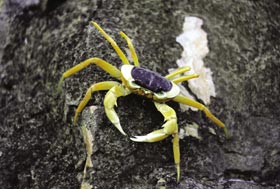
Photo Kay Van Damme.
Branchipodopsis relictus Van Damme, Weekers & Dumont, 2002. An endemic Fairy Shrimp that occurs in temporary freshwater pools that form on rocks in Socotra, like at Eriosh. Swims upside down and filters water for phytoplankton.
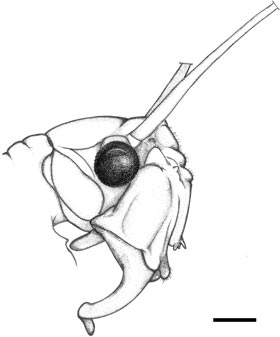
New endemic species only described recently, lives in freshwater pools (here a drawing of the head), Branchipodopsis relictus, a fairy shrimp that swims upside down and filters water.
Drawing Kay Van Damme.
Moina diksami Van Damme & Dumont, 2007. Endemic Water Flea, less than 2mm long, lives in water inside burrows of the large freshwater crabs on the Diksam Plateau.
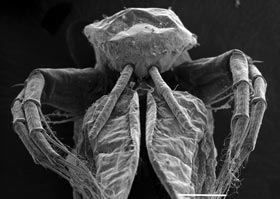
Another new species, described in 2007, an endemic Water Flea of Socotra from Diksam Plateau, known as Moina diksamensis. The animal is small, the scale bar indicates 0.1mm.
Photo Kay Van Damme, Ghent University.
International conservation status
Socotra has been widely recognized as globally important as a whole, but a considerable number of individual species are recognized internationally to be protected as well. Several Socotran species have been included in the IUCN Red List, listed and evaluated by specialists that examine abundance of populations, threats that affect them and identify needs for action.
Most species included in the Red List are internationally recognized as facing a realistic to high risk of global extinction, especially local endemics on an island. Red listing shows a valid concern of specialists for the survival of several Socotran species.
Overgrazing, habitat destruction, introduced species and overcollection (e.g., by succulent enthousiasts) are realistic threats on Socotra leading to direct loss of biodiversity. The latter, export of specimens by collectors is illegal, yet sadly occurs. The threats listed here are well known from numerous examples in history to lead to direct extinction of species on islands, which are more vulnerable to changes than on continents.
To try and reduce the risk of international trade of fauna and flora, several Socotran species, both marine as well as terrestrial, are also listed under CITES, an international agreement between governments.
A few examples of Socotran species in the IUCN Red List:
Dendrosicyos socotrana – Endemic plant, the Cucumber Tree, listed as Vulnerable. Increased livestock and overgrazing form a major threat.
Dracaena cinnabari – Endemic plant, the well-known Socotra Dragon’s Blood Tree, listed as Vulnerable. Drought and exploitation are considered as threats to the species’ local survival.
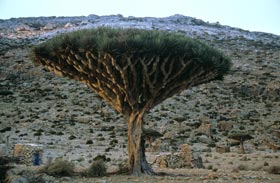
The Dragon’s Blood Tree is included in the IUCN Red List, indicated as a Vulnerable species. It means that experts consider its future extinction on the island as realistic.
Photo: Kay Van Damme
Aloe perryi – Endemic plant, Near Threatened. One of several endemic Aloes on the island, potentially vulnerable to over-harvesting. Also included in CITES.
Cisticola haesitatus – Endemic bird, Socotra Cisticola. Listed as Near Threatened. Overgrazing is considered as a realistic threat for this species.
Socotra pseudocardisoma – Endemic Crab (see above), occurs only locally.
Several other Socotran species are listed under CITES for Yemen, like the endemic chamaeleon Chamaeleo monachus and more endemic plants such as Euphorbia arbuscula.
Recommended Reading
Cheung, C. & DeVantier, L., 2006. Socotra: A Natural History of the Islands and their People. K. Van Damme (Science Editor). Odyssey Books and Guides, Airphoto Int. Ltd., Hong Kong, 408 pp.
The Archipelago
Did you Know
The islandís aloes were famous in ancient times, to such an extent that socotrine aloes became a concept in pharmacy.

